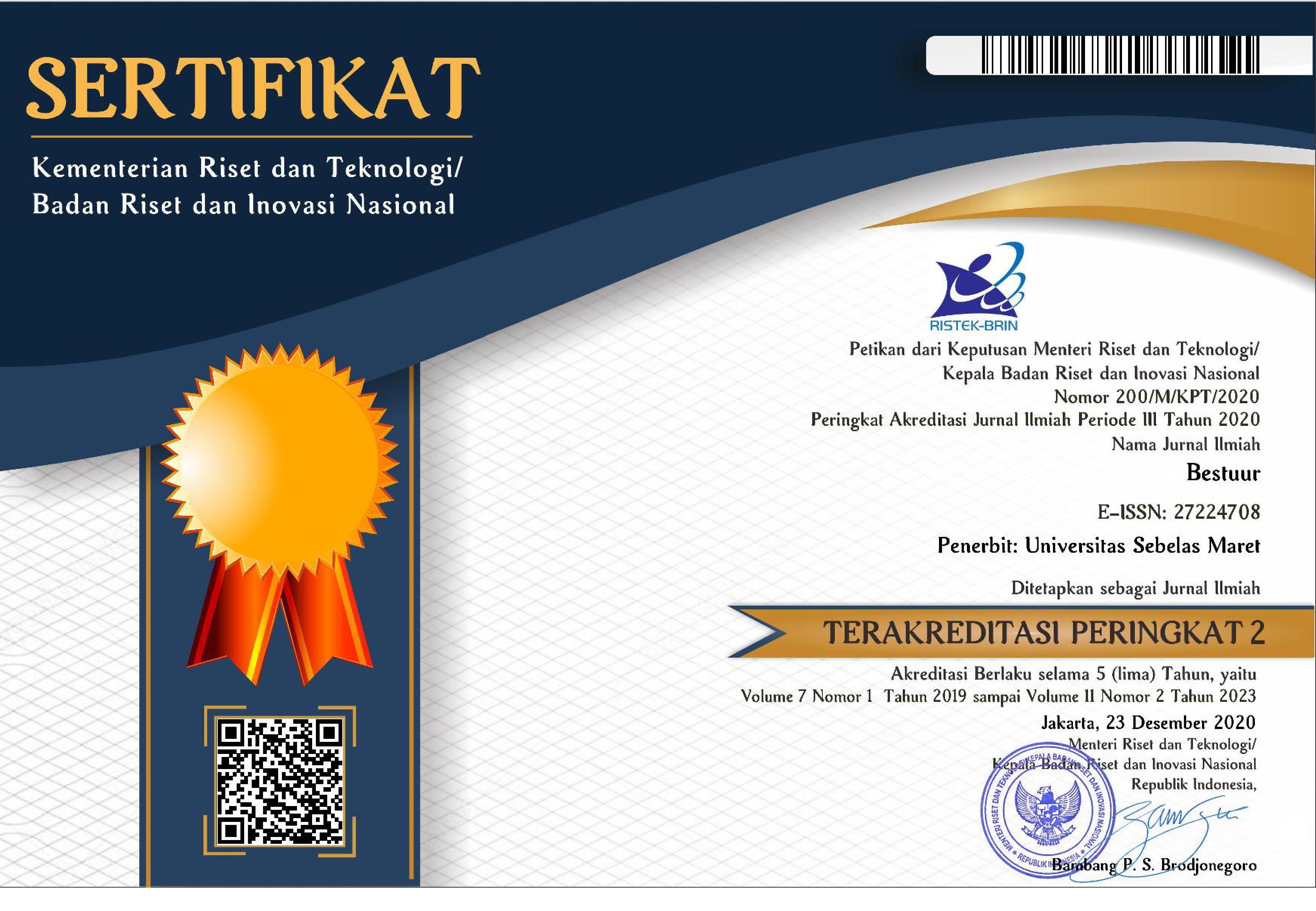Transgender and the Right to Employment in India: Analysing the Trajectories of Discrimination
Abstract
Keywords
Full Text:
PDFReferences
Arabandi, B. (2016). Karma and the myth of the new Indian super woman: Missing women in the Indian workforce. In Land, Labour and Livelihoods (pp.177-196). Springer International Publishing. https://doi.org/10.1007/978-3-319-40865-1_9
Ayu Ketut Rachmi Handayani, I. G., Pujiyono, & Sari, S. D. (2020). Forensic and toxicological tests for protecting the patients of esthetic beauty clinic as the constitutional right in Indonesia. Indian Journal of Forensic Medicine and Toxicology, 14(2), 2543–2547. https://doi.org/10.37506/ijfmt.v14i2.3498
Chakrapani, V., Shunmugam, M., Newman, P. A., Kershaw, T., & Dubrow, R. (2015). HIV status disclosure and condom use among HIV-positive men who have sex with men and hijras (male-to-female transgender people) in India: Implications for Prevention. Journal of HIV/AIDS and Social Services, 14(1), 26–44. https://doi.org/10.1080/15381501.2013.859113
De Vries, K. M. (2015). Transgender people of color at the center: Conceptualizing a new intersectional model. Ethnicities, 15(1), 3–27. https://doi.org/10.1177/1468796814547058
Divan, V., Cortez, C., & Smelyanskaya, M. (2016). Transgender social inclusion and equality: a pivotal path to development. Journal of the International AIDS Society, 19(2). https://dx.doi.org/10.7448%2FIAS.19.3.20803
Dutta, S., Khan, S., & Lorway, R. (2019). Following the divine: an ethnographic study of structural violence among transgender jogappas in South India. Culture, Health & Sexuality, 21(11), 1240–1256. https://doi.org/10.1080/13691058.2018.1555718
Gilbertson, A. (2018). Between inclusivity and feminist purism: Young gender justice workers in post-Nirbhaya Delhi. Women’s Studies International Forum, 67, 1–9. https://doi.org/10.1016/j.wsif.2017.12.003
Jethva, H., Chand, D., Torres, O., Gupta, P., Lyapustin, A., & Patadia, F. (2018). Agricultural burning and air quality over northern india: A synergistic analysis using nasa’s a-train satellite data and ground measurements. Aerosol and Air Quality Research, 18(7), 1756–1773. https://doi.org/10.4209/aaqr.2017.12.0583
Ming, L. C., Hadi, M. A., & Khan, T. M. (2016). Transgender health in India and Pakistan. The Lancet, 388(10060), 2601–2602. https://doi.org/10.1016/S0140-6736(16)32222-X
Nuryanto, A. D. (2019). Problem penyidikan tindak pidana pencucian uang yang berasal dari predicate crime perbankan. Bestuur, 7(1), 54. https://doi.org/10.20961/bestuur.v7i1.43437
Philip, J., & Soumyaja, D. (2019). Workplace diversity and inclusion: policies and best practices for organisations employing transgender people in India. International Journal of Public Policy, 15(3/4), 299. https://doi.org/10.1504/IJPP.2019.103011
Poteat, T., & Scheim, A. (2016). Global epidemiology of HIV infection and related syndemics affecting transgender people. In Acquir Immune Defic Syndr (Vol. 27, pp. 1–10). https://doi.org/10.1097/qai.0000000000001087
Schmidt, S. J., Chang, S., Carolan-Silva, A., Lockhart, J., & Anagnostopoulos, D. (2012). Recognition, responsibility, and risk: Pre-service teachers’ framing and reframing of lesbian, gay, and bisexual social justice issues. Teaching and Teacher Education, 28(8), 1175–1184. https://doi.org/10.1016/j.tate.2012.07.002
Sema, S. A. (2019). The subversive use of parading effeminacy by transgender people in increasing crime rate in Bangladesh: A study on several investigating crime reports. British Journal of Arts and Humanities, 1(6), 45–55. https://doi.org/10.34104/bjah.019.45055
Sineath, R. C., Woodyatt, C., Sanchez, T., Giammattei, S., Gillespie, T., Hunkeler, E., Owen-Smith, A., Quinn, V. P., Roblin, D., Stephenson, R., Sullivan, P. S., Tangpricha, V., & Goodman, M. (2016). Determinants of and barriers to hormonal and surgical treatment receipt among transgender people. Transgender Health, 1(1), 129–136. https://doi.org/10.1089/trgh.2016.0013
Singh, A. A., & McKleroy, V. S. (2011). “Just getting out of bed is a revolutionary act”: The resilience of transgender people of color who have survived traumatic life events. Traumatology, 17(2), 34–44. https://doi.org/10.1177/1534765610369261
Singh, Y., Aher, A., Shaikh, S., Mehta, S., Robertson, J., & Chakrapani, V. (2014). Gender transition services for hijras and other male-to-female transgender people in India: Availability and barriers to access and use. International Journal of Transgenderism, 15(1), 1–15. https://doi.org/10.1080/15532739.2014.890559
Triwanto, T., & Aryani, E. (2020). The urgency of granting authority to assess corruption justice collaborators. BESTUUR, 8(1), 60. https://doi.org/10.20961/bestuur.v8i1.42720
Vaitses Fontanari, A. M., Zanella, G. I., Feijó, M., Churchill, S., Rodrigues Lobato, M. I., & Costa, A. B. (2019). HIV-related care for transgender people: A systematic review of studies from around the world. Social Science & Medicine, 230, 280–294. https://doi.org/10.1016/j.socscimed.2019.03.016
Winter, S., Diamond, M., Green, J., Karasic, D., Reed, T., Whittle, S., & Wylie, K. (2016). Transgender people: Health at the margins of society. The Lancet, 388(10042), 390–400. https://doi.org/10.1016/S0140-6736(16)00683-8
Wylie, K., Knudson, G., Khan, S. I., Bonierbale, M., Watanyusakul, S., & Baral, S. (2016). Serving transgender people: Clinical care considerations and service delivery models in transgender health. The Lancet, 388(10042), 401–411. https://doi.org/10.1016/S0140-6736(16)00682-6
Zubaidi, N., Pratama, R. G., & Al-Fatih, S. (2020). Legal perspective on effectiveness of pre-Work cards for Indonesian people. Bestuur, 8(1), 9. https://doi.org/10.20961/bestuur.v8i1.42722
DOI: https://doi.org/10.20961/bestuur.v9i1.51997
Refbacks
- There are currently no refbacks.
Copyright (c) 2021 Utkarsh K. Mishra, Abhishek Negi
License URL: https://creativecommons.org/licenses/by/4.0/
|











_CROSREF.jpg)




